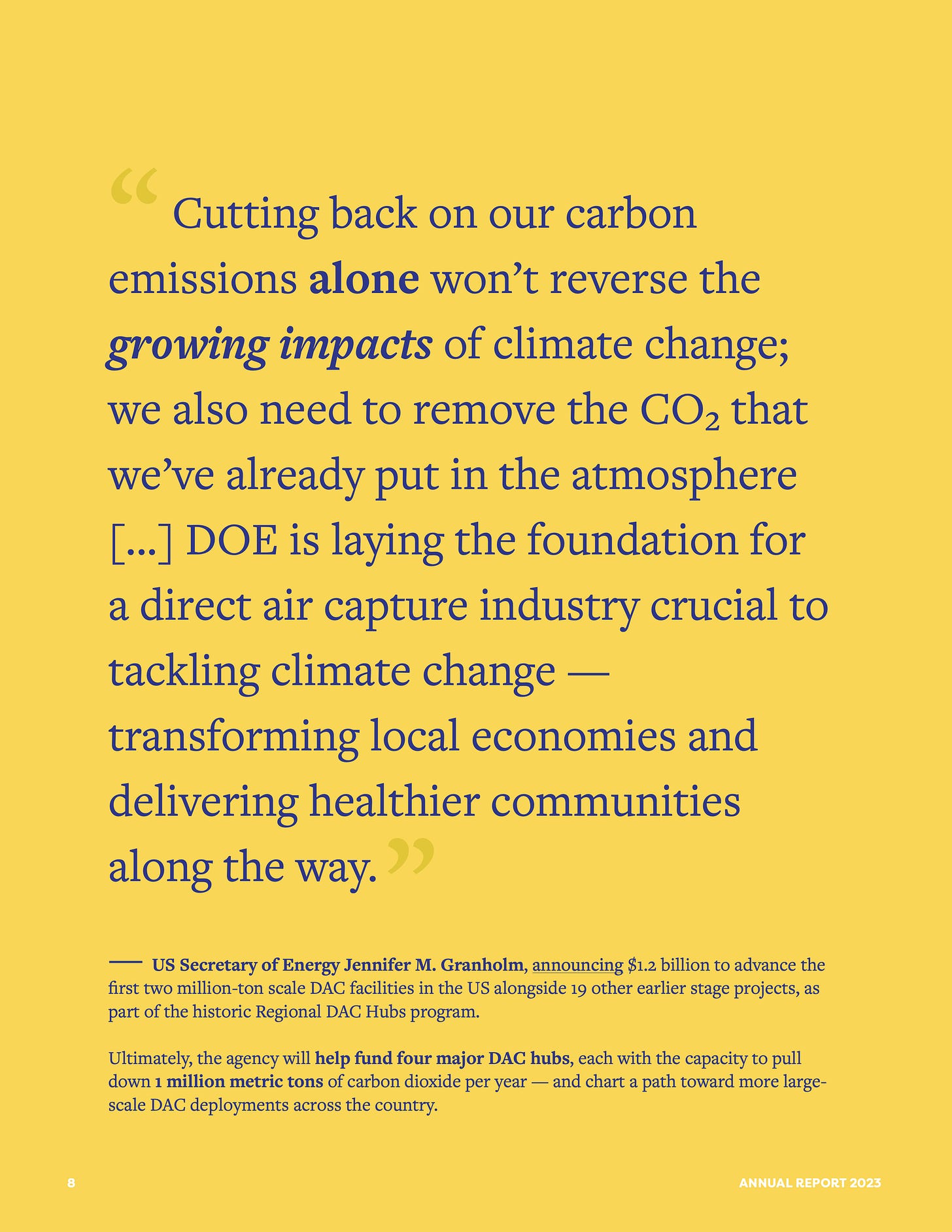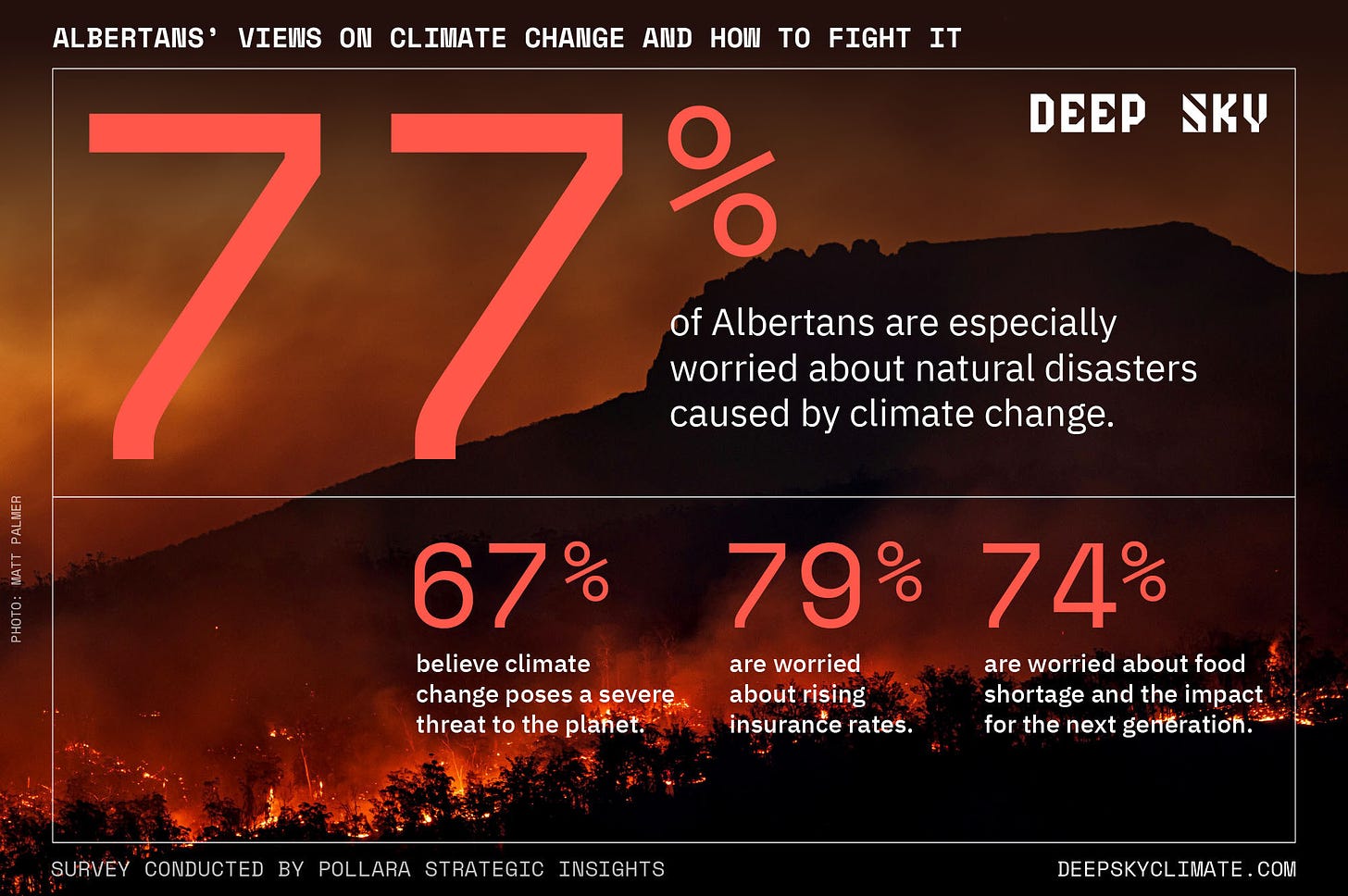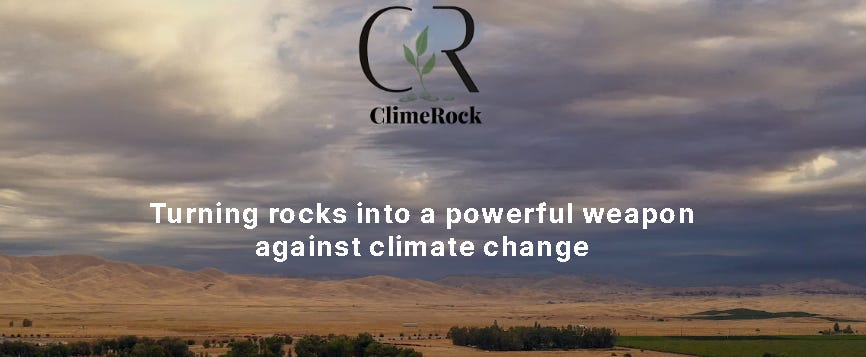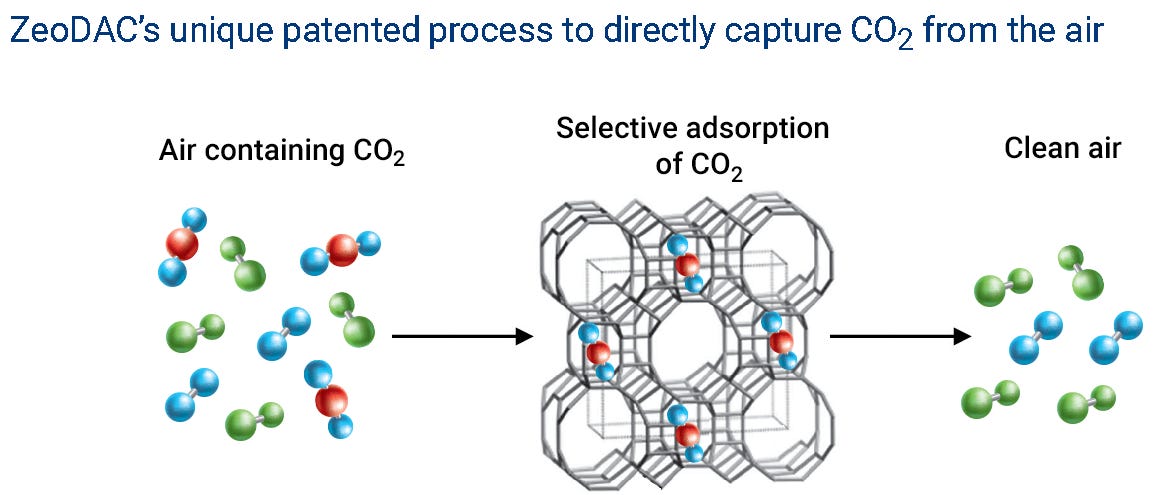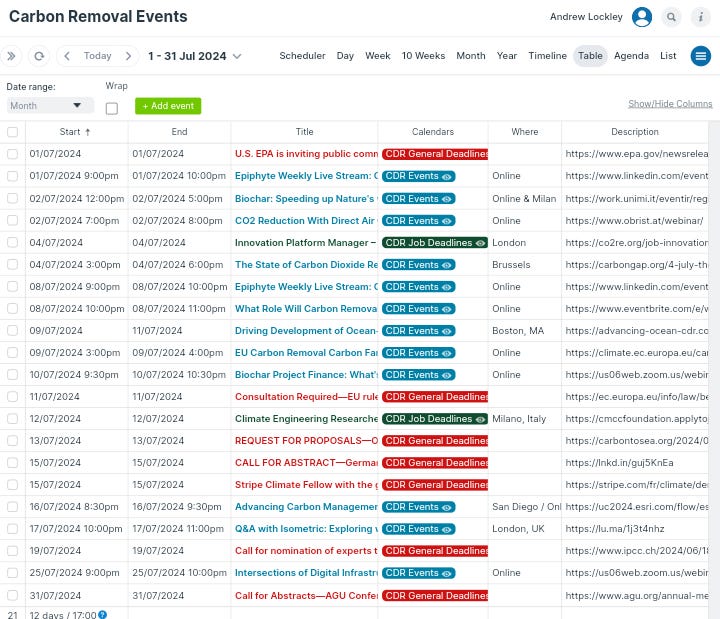CARBON REMOVAL WEEKLY SUMMARY (01 JULY - 07 JULY 2024)-WEEK#27
Links to recent scientific papers, web posts, upcoming events, job opportunities, podcasts, and event recordings, etc. on Carbon Dioxide Removal Technology.
💸COMMERCIAL NEWS
Yama secured $3 million in funding to scale their breakthrough hybrid electrochemical direct air capture technology (LinkedIn)
Commission approves €3 billion Swedish State aid scheme to support the roll-out of biogenic carbon dioxide capture and storage (European Commission)
The city of Minneapolis plans to build a $1.5 million biochar production facility for carbon sequestration (Bizjournal)
Cdr.fyi partnered with carbon data company, Sylvera to showcase supplier progress with Sylvera to scale durable CDR 1,000x (cdr.fyi)
NetZero inaugurates its third biochar factory and launches the construction of a new site in Brazil (Net Zero)
Canadian Parliament Passes Bill C-59, Providing CCUS Investment Tax Credit (Global CCS Institute)
Austria's federal government adopted a carbon management strategy including CDR, CCS & CCU as a contribution to achieving climate neutrality (BMK.Gv)
Varaha Launches Enhanced Rock Weathering Program For The Global South (Carbon Herald)
New protocol for biochar production and storage (Isometric)
Puro.earth Launches New Carbon Removal Verification Fee Structure (Carbon Herald)
Planetary Technologies and researchers at Dalhousie University’s Oceanography Department are collaborating to study OAE (Planetary)
Partanna in tie-up with KAUST to optimise carbon negative concrete (TradeArabia)
Austria Unveils Roadmap For Deployment Of Carbon Capture & Removal (Carbon Removal)
Japanese consortium to pilot urban DAC technology (Carbon Pulse)
📝RESEARCH PAPERS
Carbon dioxide removal and net zero emissions in Africa: An integrated assessment modelling based on three different land-based negative emission solutions
Ampah, J. D., Afrane, S., Adun, H. H., Dioha, M., Agyekum, E. B., Yusuf, A. A. A., ... & Bamisile, O. (2024). Carbon dioxide removal and net zero emissions in Africa: An integrated assessment modelling based on three different land-based negative emission solutions. Environmental Research Letters.
Synopsis: Africa remains understudied despite being a target for carbon removal schemes. Modeling net-zero emissions (NZE) by 2050 with afforestation/reforestation (AR), BECCS, and biochar, this research finds potential removals of 1.2 GtCO2/yr with all approaches, and 0.5 GtCO2/yr with AR alone. The most expensive and least effective strategy involves only AR or AR with biochar. NZE by 2050 could reduce cropland by 30-90%, impacting food security, especially in Southern Africa. AR only would raise food prices the most, while AR-BECCS-biochar would minimize this rise. Balanced, region-specific strategies are crucial for sustainability.
The Science, Engineering, and Validation of Marine Carbon Dioxide Removal and Storage
Doney, S. C., Wolfe, W. H., McKee, D. C., & Fuhrman, J. G. (2024). The Science, Engineering, and Validation of Marine Carbon Dioxide Removal and Storage. Annual Review of Marine Science, 17.
Synopsis: Ocean-based CDR techniques show promise but aren't ready for large-scale deployment due to scientific and engineering gaps. These methods need research on efficacy, permanence, and validation, as well as studies on scalability, costs, energy demands, and technical readiness. Additionally, research on co-benefits, ocean acidification, environmental and social impacts, and governance is essential.
A Comparative Review of Soil Carbon Sequestration Methods in Brazil’s Agriculture
Cheng, S. (2024). A Comparative Review of Soil Carbon Sequestration Methods in Brazil’s Agriculture. Discussions, 20(1), 4.
Synopsis: Brazil's biodiversity and agriculture sector face challenges like soil degradation and rising atmospheric carbon. Integrated agricultural systems and biochar can improve carbon sequestration and soil fertility. This paper proposes a model where biochar stabilizes integrated systems, and integrated systems reduce biochar costs. Environmental and economic impacts are analyzed, along with policy recommendations. Findings suggest that combining these methods can address barriers and enhance sustainability.
Mass-Balance MRV for Carbon Dioxide Removal by Enhanced Rock Weathering: Methods, Simulation, and Inference
Baum, M., Liu, H., Schacht, L., Schneider, J., & Yap, M. (2024). Mass-Balance MRV for Carbon Dioxide Removal by Enhanced Rock Weathering: Methods, Simulation, and Inference. arXiv preprint arXiv:2407.01949.
Synopsis: Carbon dioxide removal from the atmosphere is crucial to mitigate future climate change. Enhanced rock weathering (ERW) is a promising method, improving soil health and crop yields. Accurate quantification of carbon removal by ERW is challenging. This paper reviews mass-balance methods to monitor soil base cations, experimental planning, and a software package for ERW tasks. It highlights Bayesian inference's advantages, demonstrating its effectiveness with a model using simulated data.
Dependence of the formation kinetics of carbon dioxide hydrate on clay aging for solid carbon dioxide storage
Liu, H., Wang, S., Fu, Y., Shi, C., Song, Y., Zhang, L., ... & Ling, Z. (2024). Dependence of the formation kinetics of carbon dioxide hydrate on clay aging for solid carbon dioxide storage. Journal of Colloid and Interface Science.
Synopsis: Clay-based marine sediments have potential for CO2 encapsulation via solid gas hydrates. However, clay aging alters surface properties, complicating hydrate formation. Using ultrasonication and plasma treatment to simulate aging, this paper found that breakage and oxidation of clay nanoflakes disrupt siloxane rings and graft hydroxyl groups, reducing negative charge density and weakening interfacial interactions. This prolongs CO2 hydrate nucleation by disrupting surrounding water structures. These findings enhance understanding of clay's structure-function relationship with CO2 hydrate formation, aiding hydrate-based CO2 storage development.
How to maintain environmental integrity while realising BECCS projects via co-financing by state support and the VCM -A Swedish case study
Pehrs, M., Möllersten, K., & Zetterberg, L. How to maintain environmental integrity while realising BECCS projects via co-financing by state support and the VCM-A Swedish case study. Frontiers in Environmental Science, 12, 1387138.
Synopsis: This paper examines financing BECCS in Sweden, a key CDR method. Swedish policy supports BECCS with results-based payments, and demand for CDR carbon credits is rising. Current policies may subsidize carbon credit prices on voluntary carbon markets (VCM), potentially lowering decarbonization efforts. Proportional attribution—assigning mitigation outcomes based on financial contribution—and adjustments in GHG accounting are recommended to prevent double claiming and maintain environmental integrity. These findings have wider implications for BECCS co-financing and climate policy.
Investigation of an Indian Site with Mafic Rock for Carbon Sequestration
Saif, M., Kiran, R., Rajak, V. K., & Verma, R. K. (2024). Investigation of an Indian Site with Mafic Rock for Carbon Sequestration. ACS Omega.
Synopsis: The increasing greenhouse gas emissions necessitate developing atmospheric carbon dioxide removal and storage techniques, including geological sequestration. Mafic and ultramafic rocks are ideal for long-term sequestration due to stable carbonate formation but face injectivity issues. This study examines rock samples from an Indian site, characterizing them with X-ray fluorescence, X-ray diffraction, Raman spectroscopy, and FESEM. Mineralogical analysis reveals 10% diopside. CO2 sequestration potential is simulated, showing magnesite formation. Hydraulic fracturing can address low porosity and permeability, with fracturing pressure likely at 2100 psi according to Monte Carlo analysis.
Legal Issues in Oceanic Transport of Carbon Dioxide for Sequestration
Arlota, C., Gerrard, M. B., & Mahadevan, P. D. (2024). Legal Issues in Oceanic Transport of Carbon Dioxide for Sequestration.
Synopsis: Large CO2 sequestration facilities are being developed in Texas and Louisiana, accessible to ships. Europe, lacking adequate sequestration facilities, considers shipping captured CO2 to the U.S. for storage. This report examines legal aspects of CO2 shipping, highlighting legal uncertainties, market mechanisms under the Paris Agreement, U.S. laws, and liability regimes. It calls for clarity on international CO2 transport for storage, analyzing domestic and international laws. The report provides a comprehensive legal framework, emphasizing global and regional agreements beyond a Eurocentric perspective.
CO2 Removal Potential of Two Ocean-based NETs in Earth System Models in a Realistic Deployment Scenario
Bergman, T., Bourgeois, T., Schwinger, J., Foteinis, S., Renforth, P., Seifert, M., ... & Partanen, A. I. (2024). CO2 Removal Potential of Two Ocean-based NETs in Earth System Models in a Realistic Deployment Scenario (No. EGU24-18363). Copernicus Meetings.
Synopsis: Negative emission technologies are key to limiting global warming to 1.5°C. Ocean alkalinization and direct CO2 removal show high potential. This study uses Earth System Models to simulate realistic global ocean alkalinization scenarios with CaO in US, Europe, and China. Starting in 2030, CO2 concentrations drop by 7 ppm by 2100, but the efficacy and detectability of alkalinity enhancement are concerns. Earlier deployments don't significantly impact temperature, highlighting limited carbon removal potential. Further analysis of broader Earth system effects is needed.
Cellulose-based aerogel derived N, B-co-doped porous biochar for high-performance CO2 capture and supercapacitor
Xiao, J., Yuan, X., Li, W., Zhang, T. C., He, G., & Yuan, S. (2024). Cellulose-based aerogel derived N, B-co-doped porous biochar for high-performance CO2 capture and supercapacitor. International Journal of Biological Macromolecules, 269, 132078.
Synopsis: Porous biochar's unique properties make it ideal for CO2 capture and supercapacitors. This study synthesized N, B-co-doped porous biochar (NBCPB) via carbonating and activating dual-doped cellulose aerogel. NBCPB-650-1, with a micropore volume of 0.40 cm³·g⁻¹ and specific surface area of 891 m²·g⁻¹, showed excellent CO2 adsorption (4.19 mmol·g⁻¹ at 100 kPa and 25°C) and high CO2/N2 selectivity, retaining >97.5% after 10 cycles. It also delivered high capacitance (220.9 F·g⁻¹ at 1 A·g⁻¹) and energy density (9 Wh·kg⁻¹). This study highlights NBCPB-650-1's potential in CO2 capture and energy storage, offering scalable production insights.
Gigatonne Carbon Dioxide Removal: Reversing Global Heating Trends
Valone, T. F. (2024). Gigatonne Carbon Dioxide Removal: Reversing Global Heating Trends.
Synopsis: The study emphasizes the urgent need for gigatonne-scale carbon dioxide removal (CDR) technologies to mitigate global warming. It underscores the close correlation between global CO2 levels and temperature, highlighted by James Hansen's climate history mapping. The research advocates for annual CDR of 40 gigatonnes to stabilize CO2, followed by scaling up to 100 gigatonnes/year to reverse temperature trends. This approach could provide a cost-effective method to capture atmospheric carbon and facilitate the transition to renewable energy sources.
A Collective Intelligence assembly approach to informing responsive net zero policy design: A greenhouse gas removal UK case study
Hardisty, A., & Workman, M. (2024). A Collective Intelligence assembly approach to informing responsive net zero policy design: A greenhouse gas removal UK case study. Collective Intelligence, 3(2), 26339137241254099.
Synopsis: The study underscores the necessity for large-scale removal of anthropogenic CO2 alongside emission reductions to combat global warming. It explores the application of collective intelligence (CI) models in the UK's greenhouse gas removal (GGR) sector, emphasizing the need for sustainable scaling and acceleration. Through systems mapping, thematic analysis, and interviews, it identifies potential for CI to enhance system visibility, stakeholder engagement, and shared vision formation for GGR in the UK's net zero strategy. The proposal suggests establishing a publicly accessible 'commons' to visualize and enhance ecosystem awareness, fostering a collective culture and robust GGR sector development.
Soil organic and inorganic carbon interactions under tillage and cover cropping determine potential for carbon accumulation in temperate, calcareous soils
Li, S., Chen, X., Hu, M., Geng, Y., Sui, S., Meng, S., ... & Cui, W. (2023). Carbon sequestration effects in cementitious composite binder materials under accelerated carbonation: A review. Materials Today Sustainability, 100663.
Synopsis: This study examines the dynamics of soil organic carbon (SOC) and soil inorganic carbon (SIC) in calcareous soils under different tillage intensities and cover cropping. It finds significant interactions between SOC and SIC stocks, influenced by tillage depth and cover crop presence. Ploughing enhances SOC content and positively correlates with SIC stock, suggesting a potential for carbon sequestration. The study underscores the complexity of SOC-SIC interactions and emphasizes the need for tailored soil carbon management strategies in calcareous soils.
Dynamic analysis of a floating wind turbine platform with on-board CO2 direct air capture
Domene, G. A., & Crawford, C. (2024). Dynamic analysis of a floating wind turbine platform with on-board CO2 direct air capture. Ocean Engineering, 308, 118205.
Synopsis: This paper explores the integration of offshore wind-powered CO2 direct air capture (DAC) technology with a floating wind turbine (FWT) platform. Using the IEA 15 MW RWT atop the UMaine VolturnUS-S semi-submersible as a reference, the study analyzes the design modifications needed for stable DAC integration. It evaluates the platform's mass distribution, stability under wave conditions, and impact on power production, demonstrating comparable performance to the reference design. The findings suggest that the FWT-DAC platform could offer a feasible modular approach for deploying DAC systems at sea.
Bamboo charcoal application altered the mineralization process of soil organic carbon in different succession stages of karst forest land
Hu, L., Liu, X., Xie, Y., Zeng, Y., Qu, H., Yu, Y., & He, T. Bamboo charcoal application altered the mineralization process of soil organic carbon in different succession stages of karst forest land. Frontiers in Environmental Science, 12, 1411122.
Synopsis: The study investigates the impact of bamboo charcoal application on soil organic carbon (SOC) dynamics across different forest succession stages (virgin, secondary, planted) in karst areas. Using varying charcoal addition ratios, it examines SOC content, mineralization potential (C0/SOC), carbon fractions, and soil enzyme activity. Results indicate that bamboo charcoal enhances SOC content, with the highest increase observed in planted forests at 4.0% addition. However, effects on C0/SOC vary by forest type, suggesting nuanced impacts of bamboo charcoal on carbon sequestration potential across forest succession stages.
Review on Advances and Prospectives of Direct Air Capture: Thermodynamic Verification, Optimized Material Selection, and Technical Economic Assessment for the Application
Yi, C., Guan, B., Zhuang, Z., Chen, J., Guo, J., Chen, Y., ... & Huang, Z. (2024). Review on Advances and Prospectives of Direct Air Capture: Thermodynamic Verification, Optimized Material Selection, and Technical Economic Assessment for the Application. Industrial & Engineering Chemistry Research.
Synopsis: This review addresses the urgent need for direct air capture (DAC) technologies to mitigate anthropogenic CO2 emissions, crucial for meeting the goals of the Paris Agreement. It categorizes DAC systems into gas/solid, gas/liquid, and gas/polymer types, evaluating their thermodynamic feasibilities. The paper emphasizes industrial-scale DAC technologies, highlighting advancements, process flows, and techno-economic analyses, with case studies of demonstration plants like Climeworks. It discusses the maturity, advantages, and challenges of DAC technologies, offering insights for future research and development directions.
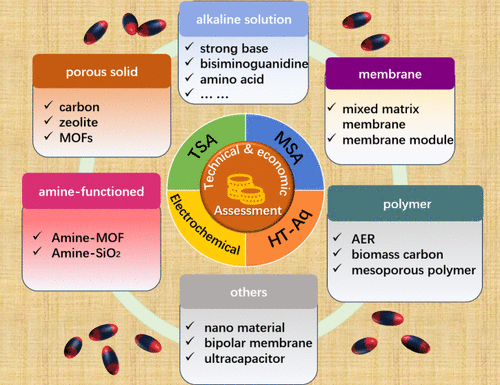
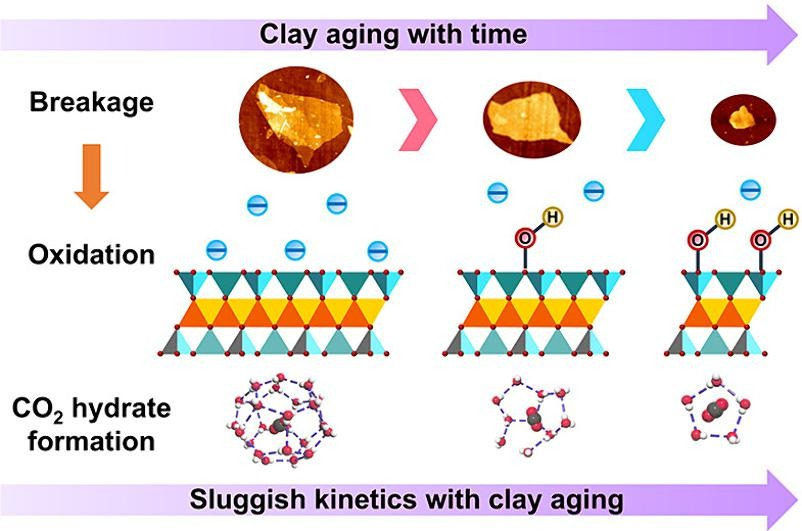
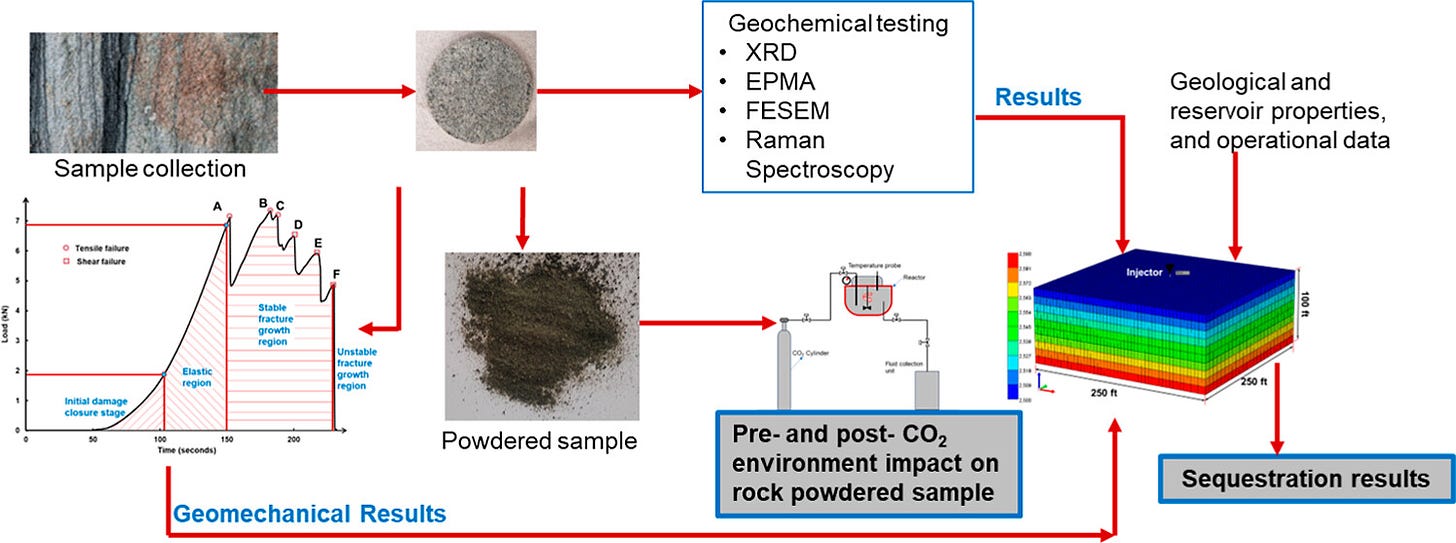
📰WEB POSTS
The Convergence of the Voluntary and Compliance Carbon Markets (Inside Climate Policy)
In the California desert, a new wastewater plant might hold the key to cheap carbon removal (Fast Company)
Regenerative Agriculture: Barriers To Adoption And How Leaders Can Help (Forbes)
A Guide for Newcomers to the CDR Industry (Ricks Substack)
Policymakers take on “high-integrity” carbon removal (Carbon180)
Carbon Removal Industry Reckons With a New Problem — Too Many Startups (Bloomberg)
Mammoth Facility Setting the Bar High for Direct Air Capture Technologies (Securities.io)
Ocean Visions submitted comments on WHOI's tentative EPA permit to conduct ocean alkalinity enhancement field trials (Ocean Visions)
Deep Sky Survey Reveals Albertans desire to See Canada Lead in Carbon Removal (Newswire)
GESAMP list of ocean CDR proposals (as of 31 May 2024) (GESAMP)
Metro Vancouver plans 2025 trial to remove CO2 from sea water (Vancouver Sun)
Breakthrough research on tiny ocean creatures promises better CO2 removal (goodgood)
Greenhouse Adventures: A journey through unexpected obstacles (Part 2) (Carbon Drawdown Initiative)
📃REPORTS
2023 Annual Report by Carbon180
Removing Methane via Atmospheric Oxidation Enhancement: The Legal Framework
Carbon & Emissions Tech Overview
📒BOOK
Carbon Dioxide Sequestration in Cementitious Construction Materials
🧰CDR FIRMS
ClimeRock
ZEODAC
🚨UPCOMING EVENTS
EU Carbon Removal Carbon Farming Certification – Online Workshop on Peatland rewetting | 09 July 2024 | Online
Driving Development of Ocean-Based Carbon Removal Technologies with Innovations in MRV, Oceanographic Modelling & New Policy Frameworks to Reduce Global CO2 Emissions | 9-11 July 2024
Biochar Project Finance: What's available today and where do we want to go? by IBI & Kita | 10 July 2024 | Online
Advancing Carbon Management: Insights from Land to Sea Using ArcGIS Tools | 16 July 2024 | San Diego / Online
Q&A with Isometric: Exploring women-led innovation in Carbon Dioxide Removal (CDR) by Isometric | 17 July 2024 | London, UK
Intersections of Digital Infrastructure and Carbon Removal by Carbon Business Council and Climate Collective | 25 July 2024 | Online
(NEW) Intersections of Digital Infrastructure and Carbon Removal | 25 July 2024 | Online
2nd Biochar Malaysia Association International Conference 2024 by International Biochar Initiative | August 13-14, 2024
Goldschmidt 2024 conference, Chicago | 18-23 August 2024
Carbon Unbound Europe | 11-12 September 2024
Carbfix Mineralization Summit 2024 | 12-13 September 2024
Grounding Carbon Farming at Wageningen University & Research by WIMEK in collaboration with SBL, ENP, NGO myclimate, and the farm "La ferme de Hyaumet" | 14-20 September 2024 | France
(NEW) Carbon Clean-up Camp | 19-22 September 2024 | UK
CO2NNECT 2024 by the Great Plains Institute's Carbon Action Alliance | 29 September - 01 October 2024 | Colorado
Bellona Climate Action Conference | 01 October 2024 | Brussels (Belgium)
Volcanoes and past climate: adventures with deep carbon | 12 October 2024 | Online & ExCeL London
IBI Biochar Study Tour: Italy by the Italian Biochar Association and the International Biochar Initiative | 16-18 October 2024 | Florence, Italy
5th EU Carbon Removals Expert Group meeting | 21-23 October 2024 | Online
How to apply biochar in sustainability management and accounting | German Biochar Forum | 18 November 2024
We have curated a “Carbon Removal Events Calendar.” Explore and stay informed about upcoming events, conferences, and webinars on Carbon Dioxide Removal technology. Sync specific events / all events to your default calendar to ensure you never miss out on important CDR updates.
GUIDELINES:
Sync selected events to your default calendar in these simple steps:
1) Click on the event you want to sync.
2) Tap the menu icon (three vertical lines) at the top left.
3) Choose 'Share.'
4) Pick your default calendar.
5) Save the event.
Sync the entire Teamup Calendar to your default calendar with these simple steps:
1) Tap the menu icon (three vertical lines) at the top right.
2) Choose 'Preferences.'
3) Click 'iCalendar Feeds.'
4) Copy the URL shown for 'CDR Events / CDR General Guidelines / CDR Job Deadlines.'’
5) Paste the URL into your default calendar settings.
6) Click 'Subscribe' or 'Add Calendar.'
For more detailed instructions, visit: https://calendar.teamup.com/kb/subscribe-to-teamup-icalendar-feeds/
You can directly sync all Carbon Removal events to your default calendars by pressing the link below:
💼JOB OPPORTUNITIES
Program Director; Marine Carbon Dioxide Removal at Ocean Visions | Deadline to apply: 19 July 2024
"Ocean Visions is a non-profit organization that catalyzes innovation at the intersection of the ocean and climate crises. We facilitate multisector collaborations from within our Network and beyond, working with leading research institutions, the private sector, and public-interest organizations to fully explore and advance responsible and effective ocean-based climate solutions."
Analyst position – Offtake & Investment Solutions team at Puro.earth | Remote, Americas
"Puro.earth, a forerunner as a carbon removal crediting program, is on the lookout for a new team member for the Offtake & Investment Solutions team (“OIS”). Puro’s OIS team complements the core work of certification delivered by Puro.earth, by ensuring that demand, financing and risk-mitigation solutions are available in the market to support the much-needed growth of the ecosystem."
Forest Carbon Geospatial Scientist at Carbon Direct | USA
"Carbon Direct is a purpose-driven carbon management firm dedicated to making carbon science actionable with our end-to-end platform."
Software Developer at Planetary Technologies | Remote, Canada
"Planetary Technologies’ vision is to restore the climate and heal the ocean for generations to come. We do this by enhancing the ocean’s natural ability to fight climate change through carbon dioxide removal and storage. Our team combines expertise in ocean science, metallurgy and geochemistry to safely and effectively scale up ocean-based CO2 management solutions. Working collaboratively with all of our stakeholders, we develop a cost effective and sustainable set of tools aimed at protecting and restoring our oceans and climate, ultimately doing carbon dioxide removal and storage at gigatonne scale."
Senior Associate - Climate Aligned Industries, Carbon Dioxide Removal at RMI | Remote - US
"The Carbon Dioxide Removal (CDR) Initiative joined RMI in 2022 to support responsible deployment of carbon removal through advancing research and development; supporting first of a kind projects; and establishing the policy and market mechanisms to drive long-term sustainable demand for carbon removal.
Our research and development portfolio produces industry-leading technology assessments and roadmaps to identify promising CDR approaches and clarify where additional investment is needed. Our first projects portfolio works to activate new industries to invest in carbon removal and engages directly with project developers to inform project design and implementation. Our policy and market-shaping portfolio is convening stakeholders and providing actionable guidance to policymakers, agency staff, and CDR companies to establish the policies and institutions needed to scale CDR responsibly with a high bar for community engagement, equity, and justice. We work with a diverse range of partners in academia, the private sector, civil society, and government to execute this work.
The CDR Initiative sits within the Climate Aligned Industries (CAI) Program at RMI. CAI is focused on decarbonizing the harder to abate sectors through the development of policy, market mechanisms, and industry action. In addition to the CDR Initiative, CAI brings together heavy industry sectors (aviation, cement, chemicals, steel and shipping) with cross-cutting projects focused on green hydrogen, clean industrial hubs, community engagement, and demand creation."
Policy Lead at Thalo Labs | New York, United States
"Thalo Labs is a NYC-based company on a mission to transform the built environment into a powerful tool for fighting climate change. Where others see buildings as part of the problem, we see an incredible opportunity to leverage existing infrastructure to not only accelerate drawdown, but to transform the built environment from one of the biggest carbon emitters to a carbon sink. Our technology combines proprietary sensing, software, and capture systems to accurately measure, significantly reduce, and directly capture a building’s onsite greenhouse gasses in real time."
Operations Lead at Carbon Upcycling Technologies | Mississauga, Canada
"Carbon Upcycling is a waste and carbon utilization company unlocking a new frontier of circular materials. We’re tackling the biggest problems on the planet—like climate change and industrial waste. With our patented technology platform, we help the hard-to-decarbonize industry transform local industrial byproducts and natural materials into superior additives."
Junior Scientist at Alkali Earth | Twin Cities, USA
"Alkali Earth was launched in 2022 to deliver permanent carbon dioxide removal (CDR) through enhanced weathering and mineralization in gravel roads, parking lots, and industrial pads. In our projects, CDR is achieved through the formation of new carbonate minerals that accumulate over time in our gravels, meaning our approach to measurement can be direct, simple, and relatively cheap."
Forest Carbon Scientist at Pachama | San Francisco CA, Remote
"Pachama is a mission-driven company looking to restore nature to help address climate change. Pachama brings the latest technology in remote sensing and AI to the world of forest carbon in order to enable forest conservation and restoration to scale. Pachama’s core technology harnesses satellite imaging with artificial intelligence to measure carbon captured in forests. Through the Pachama marketplace, responsible companies and individuals can connect with carbon credits from projects that are protecting and restoring forests worldwide."
Production Support Engineer at Skytree | Peetri, Estonia
"At Skytree, we’re turning ideas into action in the journey toward stable, reliable, and cleaner CO2. We create smart, scalable carbon dioxide solutions that recycle atmospheric CO2 and contribute to a healthier planet."
Regional Senior Manager, NBS Project Sustainability, LATAM at South Pole | Medellin, Colombia
"South Pole is an energetic, global company offering comprehensive sustainability solutions and services. With offices spanning all continents across the globe, we strive to create a sustainable society and economy that positively impacts our climate, ecosystems and developing communities. With our solutions, we inspire and enable our customers to create value from sustainability-related activities."
Life Cycle Assessment Lead at Carbon Direct | Seattle, Oakland, United States
"Carbon Direct is a purpose-driven carbon management firm dedicated to making carbon science actionable with our end-to-end platform."
VP Finance at CEEZER | Berlin, German
"CEEZER is a platform for CO2 compensation and high-tech removal credits with access to >8.000 climate projects worldwide, verified by globally recognized registries. Transactions take place between corporations and project developers at the source, without any middlemen or hidden fees. CEEZER achieves this by providing scientific quality and pricing insights that help buyers and sellers interact while allowing them to monitor credits in a balanced, high-quality portfolio."
Director of Legal Operations at Vesta, PBC | Remote, US
"Vesta's mission is to further the science of Coastal Carbon Capture and galvanize global deployment."
Digital Marketing Executive at NEG8 Carbon | Waterford, Ireland
"Following investment in 2021, the team at NEG8 Carbon have started to commercialise our technology by producing a working prototype 1 tonne CO2/annum carbon capture unit in 2022. We are now in the process of scaling up the technology to our full-scale commercial units."
🎙️PODCASTS
Gwynne Dyer on Intervention Earth: climate mitigation, CDR & SRM | Challenging Climate
"Our guest is Gwynne Dyer, an author, columnist, broadcaster and lecturer on international affairs. In this episode, we discuss the key messages from his new book Intervention Earth: Life-Saving Ideas from the World’s Climate Engineers, based on extensive interviews with the world’s top climate scientists. We discuss his insights from these interviews on the state of our climate, and address controversies and concerns over carbon dioxide removal (CDR) and solar radiation management (SRM)."
Maddie Hall: A Different Path to the Future | Pattern Breakers
Are There Too Many Carbon Removal Startups? | Zero
"Tackling climate change now requires not just reducing planet-warming emissions to zero, but also drawing down existing carbon dioxide from the air. Over the past few years, tech companies have taken the lead to seed hundreds of startups that want to sell carbon removal credits and help companies meet climate goals. But the failure of a major startup, Running Tide, has raised questions about the long-term viability of this market. This week on Zero, we hear from Nan Ransohoff, head of climate at Stripe, and a pioneer of the carbon-removal market."
Episode 2 - Robert Höglund | The CDR Procurement Guide
🎥YOUTUBE VIDEOS
4 July - The State of Carbon Dioxide Removal in the European Union | Carbon Gap
“A month after the launch of the second edition of The State of Carbon Dioxide Removal, we met in Brussels on 4 July to look into its key findings and hear a diverse panel discuss how the EU can better lead CDR deployment on the continent and worldwide. This conversation takes root in the report’s in-depth analysis of the state of carbon dioxide removal research, development and deployment, and how it intersects with current frameworks, public perceptions and broader sustainability considerations. In that context, we will bring together authors of the report and a panel of experts to reflect on how the EU can take a more proactive role in developing regulations, funding research, development and demonstration projects, and promoting sustainable deployment of CDR technologies to address climate change.”
Webinar Recording: A Buyers Guide to Enhanced Rock Weathering | Senken
“Welcome to the kick-off episode of our new series: A Buyer's Guide to VCM Projects, where we introduce different projects within the Voluntary Carbon Market. Our first episode will present the groundbreaking carbon removal solution of Enhanced Rock Weathering (ERW). We'll explore how the solution effectively mitigates CO2 from the atmosphere by enhancing natural processes with valuable insights from leading experts in the field. Ella Holme from Isometric will first introduce us to ERW and explain the characteristics of a high-quality project. Following her, Felix Harteneck from InPlanet and Jim Mann from UNDO will share their hands-on experience with developing ERW projects. They will illustrate how ERW, when applied to agricultural soils, ensures permanent CO2 removal and what potential differences might be when implementing this technology in the Global South.This episode aims to provide insights into Enhanced Rock Weathering, looking into what it is, how it works and how it can permanently remove and store CO2-enhancing natural processes. Key Topics 1. What is Enhanced Rock Weathering: Learn how the technology works and supports natural permanent carbon sequestration and storage. 2. What defines a high-quality ERW project: Understand what the different challenges and opportunities of the technology are 3. From Brazil to the UK: Gain different perspectives on the agricultural uses of ERW from different geographical contexts.”
Partner Fireside Chat: Scaling Up Carbon Removal - From Now to Net Zero | Net-zero Forum 2024 | ETEnergyWorld
“Join us for an engaging fireside chat on 'Scaling Up Carbon Removal - From Now to Net Zero' featuring Kapil Malhotra, Global Business Unit Head - Fluoropolymers in conversation with Sudheer Pal Singh, Editor, The Economic Times, at the Economic Times India Net-zero Forum 2024.”
Let’s stop acting like greenhouse gas removal is optional | Tito-AirMiners
From Carbon Sink to Solution Unlocking the Ocean's Role in Climate Mitigation | IOI HQ
“This IOI Alumni Continuous Professional Development webinar delved into the multifaceted relationship between the Ocean and climate mitigation. Drawing upon insights from the World Ocean Review 8: The Ocean – A Climate Champion? How to Boost Marine Carbon Dioxide Uptake (WOR8), it provided a platform for interdisciplinary dialogue between IOI Alumni and the following three experts who contributed to drafting WOR8: Prof Andreas Oschlies (Head of the Biogeochemical Modelling Research Unit at the GEOMAR Helmholtz Centre for Ocean Research in Kiel) who introduced the current approaches to Carbon Dioxide Removal and the role the Ocean could play; Dr Christine Merk (Deputy Director of the Global Commons and Climate Policy Research Centre at Kiel Institute for the World Economy) who analysed Public perceptions of marine Carbon Dioxide Removal approaches; Dr Lukas Tank (Postdoctoral Researcher in the Climate Ethics, Sustainability and Global Justice research group, University of Kiel) who highlighted the Procedural Justice aspects of Marine Carbon Dioxide Removal. Lastly, the interactive Q&A session that followed in the second part of the webinar fostered a vibrant exchange of ideas, allowing participants to engage directly with the experts, share valuable insights, and discuss practical applications for their fields. This dynamic interaction helped explore actionable solutions to the complex challenges of enhancing the ocean's role in carbon sequestration.”
Carbonfuture Carbon Removal Summit 2024 | Carbonfuture
“The time for corporate action on carbon removal is now.' That was one of the key messages from our second annual Carbon Removal Summit, organized in partnership with Reuters Events, where we brought together corporate sustainability leaders with who's who in the CDR industry. Key takeaways from the event:
1. Get started today. Investing in CDR now can secure supply and pricing over the coming years, prepare your organization for future regulations, and build your brand and reputation. Meaningful action today creates real, long-term impact, both within your organization and for the industry as a whole.
2. Trust was a hot topic throughout the Summit. Companies need to be able to trust their carbon removal investments. The digital trust infrastructure —standards, digital Monitoring, Reporting, and Verification (MRV), and insurance— provides necessary transparency on credit quality and de-risks investments. Businesses can leverage this infrastructure to make informed investment decisions without needing in-house scientific expertise or extensive resources.
3. Scaling the carbon removal industry requires the innovation, implementation, and scaling of a diverse range of carbon removal technologies, and we are seeing exciting progress as technologies and projects begin to come online all over the world, from BECCS in Scandinavia to DAC in Kenya.
4.CDR policy is moving forward at a remarkable rate. We expect to see a compliance market join the purely voluntary market soon as momentum in CDR policy increases across Europe. This means action now can prepare your organization for regulations ahead, and derisk corporate engagement further.
5.Innovations in buyer agreements are helping reduce costs and securing attractive pricing on carbon removal now. Multi-year agreements, framework arrangements, and buyer clubs can help organizations get the benefits of carbon removal more cheaply than ever before.”
SB 308 - CA Assembly Natural Resources Committee Vote Livestream | OpenAir
DAC at National Institutes of Standards and Tech | AirMiners
“MRV is the fulcrum of all things CDR, and standards for DAC are crucial for that method of CDR. To that end, for our next event on June 27 we're going to unpack new testing available for DAC at the National Institutes of Standards and Technology (NIST). Guest speaker Elisabeth Mansfield will walk us through this in conversation - we're diving deep in!”
Epiphyte Weekly Live Stream: Open Source Direct Air Capture | OpenAir
“Epiphyte is a miniature, stand-alone, open source direct air capture machine that removes CO2 from the air, designed by OpenAir volunteers. Join us for our weekly zoom in which our members troubleshoot, tinker and plan improvements to the design. All are welcome!”
Florida, Carbon Removal & The Ocean Economy | OpenAir
“Florida’s 8,436 miles of coastline, the second-longest in the U.S., place the state in an advantageous position to compete and lead in the 21st century ocean economy. In addition to its natural resource advantages, the Sunshine state is home to a growing number of world-class ocean research centers, startups, investors, and public-private partnerships that have made it a globally significant center for innovative conservation, restoration and resiliency plans and activities. In this 1-hour webinar, OpenAir will convene a diverse panel of ocean economy experts and practitioners to discuss different factors that could position Florida as a major hub for carbon removal research and business in the coming years.”
🚨DEADLINES
U.S. EPA is inviting public comment on two tentative permits under the Marine Protection, Research and Sanctuaries Act for a research study on a potential climate change mitigation technique referred to as ocean alkalinity enhancement | Deadline to provide comments: 01 July 2024
Consultation Required—EU rules on land use, land use change and forestry (LULUCF) – evaluation | Deadline: 11 July 2024
Ocean Alkalinity Enhancement Joint Learning Opportunity Q&A Session by Carbon to Sea Initiative and COVE | Proposals are due by 13 July 2024
Call for Abstract—German Biochar Forum 2024: How to apply biochar in sustainability management and accounting | Deadline to apply: 15 July 2024
Stripe Climate Fellow with the goal of seeding ideas to grow demand for Carbon Removal | Deadline: 15 July 2024
Call for nomination of experts to Scoping Meeting for Methodology Report on Carbon Dioxide Removal Technologies and Carbon Capture Utilization and Storage | Deadline: 19 July 2024
Call for Abstracts—AGU Conference | Submissions are open until 31 July 2024
CDR Sessions at AGU2024:
GC089 - Large-Scale Carbon Dioxide Removal: Potentials, Considerations, and Challenges
GC054 - Connecting Science and Monitoring, Reporting and Verification (MRV) Development for Cross-Pathway Carbon Dioxide Removal (CDR) Technologies
B088 - Science-Based Carbon Dioxide Removal (CDR) Strategies that Incorporate Monitoring, Measurements, Reporting, and Verification (MMRV)
OS027 - Modeling Approaches in Support of Ocean-based Carbon Dioxide Removal (CDR) Research
SY037 - Navigating Uncertainty: Assessing and Communicating Risk in Marine Carbon Dioxide Removal Research, Development, and Deployment
GC040 - Carbon Dioxide Removal at scale: Science, technology, policy, and market
GC133 - Scaling Potentials of Carbon Dioxide Removal Technologies: Approaches, Constraints and Challenges
B045 - Enhanced Weathering for Soil-Based Carbon Dioxide Removal: Potential and Challenges
GC022 - Advancing Monitoring, Reporting, and Verification (MRV) of In-Situ, Ex-Situ, and Marine CO2 Mineralization-based Carbon Dioxide Removal (CDR)
GC005 - Advancements in Enhanced Weathering for CO2 Removal in (Sub-)Tropical Environments: Integrating MRV, Geochemical Modeling, and Life Cycle Analysis
GC057 - Data-driven approaches to improved climate impact accounting for nature-based carbon removal
GC146 - Terrestrial enhanced rock weathering and downstream processes in soils, rivers, and oceans
B039 - Drivers of forest carbon losses and effective interventions to preserve carbon in forests worldwide
S018 - Geologic Carbon Storage
OS036 - The Impact of Climate Change and Human Activities on Carbon Sequestration in Coastal Wetlands and Strategies for Carbon Sink Enhancement
GC048 - Climate Intervention, Mitigation, Adaptation, and Restoration: Assessing the Risks and Benefits of Using Earth System Models for Guidance on Climate Action
GC004 - Advancements in Climate Intervention Research Technologies, Policies and Practices: Opportunities and Issues
U013 - Ocean Negative Carbon Emission Approaches for Mitigating Climate Change: Mechanisms, Practices and Governance
GC151 - The Impact of Physical and Environmental Constraints on Deployment of Direct Air Capture of CO2




